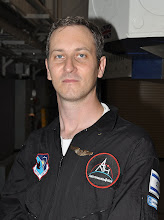 |
| The Boeing CST-100 Capsule |
If you've just robbed a bank, made a killing in the stock market or won the lottery and are about to put some Franklins down for a suborbital flight, read this joint Boeing and Space Adventures press release first, because you might want to hold on to your money a little longer and get something bigger.
According to the press release, Boeing is developing an orbital minivan (i.e. seats 7) with the very inspiring name CST-100. That by itself wouldn't make so much news as Boeing has been in the government space business for a long time, for example as a prime contractor for the International Space Station. What made news in so many space related sites and beyond (for example, have a look at this Switched article or even The Washington Post) is the collaboration with Space Adventures, that, as splattered on their home page is the only company to have sent private citizens to space. Perhaps more than anything else, it was the announcement that they plan to send orbital tourists in the new capsule by the end of 2015, meaning a little over 5 years from now.
So, should you hold on to those $200,000 burning a hole in your pocket rather than put them in an envelope marked "62 mile club" and invest them wisely hoping that in 5 years you'll have enough to go orbital? Well, maybe not. After all, just like Virgin Galactic has been 2-3 years away from flying customers for the last 5 years, like a lot of good plans, especially when space (the stuff above the atmosphere, not all that Kennedy Space Center memorabilia in your closet) is concerned, plans are, even at their best, only as good as the money being put into them.
John Elbon (I don't know if he sings very well, and anyway, it's Elbon. With a B!), Boeing's program manager for commercial crew transportation, described it in very simple words that define the treacherous, love-hate relationship of private industry and government money, as quoted in The Washington Post:
The effort to launch a space taxi by 2015 is intimately linked to NASA's commercial crew transport program.
If Congress approves money to spur the effort and Boeing wins a future contract to carry astronauts into space, then the 2015 date is possible. But if Congress postpones the commercial space program or eliminates it, then the company's efforts will be delayed or scrapped.
In the light of ever changing NASA budgets and space policy turning on a dime every 4 years or less, I have to wonder if the above reservation doesn't paint this announcement as little more than a publicity stunt with an all-too-easy escape clause. Cynicism aside, even if funding is there, even if the project is really two-thirds complete as stated in the same article (I don't know how it is in the space business, but at least in the software business the last 10% is the hardest part), the 2015 time-frame still sounds somewhat optimistic.
My suggestion - if you have the $200,000 ready and you exhausted all good uses for money (like helping me get my private pilot license and Astronauts4Hire members train to be suborbital astronauts), then go for a suborbital flight. After all, no one is getting any younger, and why wait for

 Space Shuttle Launch Poll Results
Space Shuttle Launch Poll Results













3 comments:
.
.
the Boeing CST-100 faces a long list of problems...
.
1. the CST-100 is only a paper-capsule now and 5 years are not enough to become real
.
2. develop a reliable capsule needs lots of billion$ so, who pays this bill?
.
3. the capsule is too small for seven astronauts, so, the price-per-seat could be over $200M
.
4. all the rockets able to launch this capsule (Falcon, Delta, Atlas, Ariane) AREN'T man-rated
.
5. man-rate one of these rockets needs 5-7 years and a couple of billion$ so, who pays the bill?
.
6. the capsule hasn't a Service Module, so, how can it move in space and deorbit for reentry?
.
7. the CST-100 with SM and LAS could weigh over 20 tons, so, only the $450M Delta IV Heavy can launch them
.
8. the Soyuz price-per-seat always will be only 20-30% the price of a CST-100 seat, so, it can't compete
.
9. there are no "inflatable hotels" in space now, so, how Boeing can risk to invest now billion$ blindly?
.
.
also... the Boeing CST-100 escape system is the SAME of MY idea of an "underside-LAS" proposed 3.5 years ago on my website and in/from 2007 also on several space forums and blogs!!!
.
http://www.gaetanomarano.it/articles/020newLAS.html
.
http://www.newspaceagency.com/articles/03notblueoriginidea.html
.
.
Darn it, I left my $200k in my other wallet. And wow, Gaetano, can you say BUZZ KILL?!
Hello Amnon,
I wonder if the boeing design would be a good business model, for the companies research and development potential the scope for a market builder is obviously a better prospect, the design when considering the vehicle potential really says a lot about where boeing are going as a company in the 21st century.
Companies get the gist of market positioning and ploys. For me, $200, 000 is securely with virgin galactic purely on company delivery per customer. Airplanes are 100 years old, pioneering space vehicles is a new business for encouraging our race to become sufficiently involved with the larger intricacies of becoming a space race.
For a company with such a large budget I'm sure there will be plenty of blogs asking boeing to be more adventurous.
People selling their houses and living in tents?
www.spacetravel21stcentury.blogspot.com/
Post a Comment